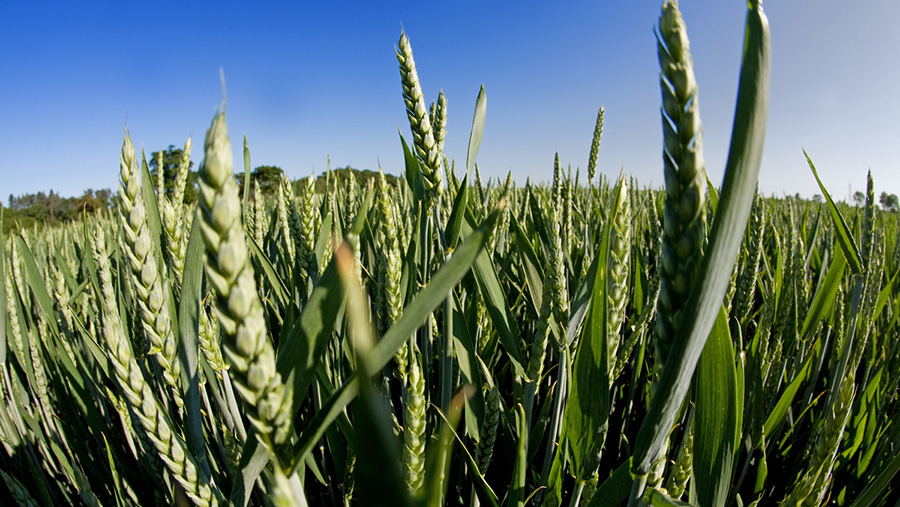Spring wheat could be better bet than malting barley in 2016
 © Tim Scrivener
© Tim Scrivener With nearly 60% of growers likely to increase the area of spring crops they drill this season according to a recent Farmers Weekly poll, four industry experts give their latest insights and advice on this year’s spring cropping.
Gleadell’s Chris Guest and Openfield’s Adrian Fisher give their thoughts and predictions on spring cropping prices and premiums for 2016-17.
Meanwhile Colin Lloyd of Agrii shares trial results and findings which suggest drilling a spring wheat variety in late autumn or in the spring could offer growers serious advantages in blackgrass control.
And as maltsters look to reduce their reliance on older, lower-yielding spring barley varieties, KWS cereals product manager Will Compson explains why spring malting variety Irina could be a good bet for the future
Prices and premiums
Chris Guest, seed manager, Gleadell
 The spring barley area is forecast to expand by 10% this harvest, bolstered by a bumper 2015 crop.
The spring barley area is forecast to expand by 10% this harvest, bolstered by a bumper 2015 crop.
Mr Guest says this will only hurt prices and erode malting premiums.
He also sees no reason for pulse prices to rise based on predictions for area increases which will squeeze margins.
He advocates growers considering a spring wheat, but warns milling premiums can be unpredictable while ergot can be a problem with plenty of rejections seen last harvest.
“Spring wheats are a good choice for growers with tight rotations because it’s a familiar crop so there’s less risk than trying spring beans or oats,” he says.
“Milling premiums are very volatile, spiking to £60/t over feed in the summer of 2014 but now they could be £10/t or below this spring. However, a poor quality harvest can change everything,” Mr Guest adds
He recommends that those growing for feed should stick to what they know and opt for a spring feed wheat variety like Kilburn from KWS.
Adrian Fisher, malting barley trader, Openfield
China’s slowing economy and a UK malting barley surplus of about 450,000t this year are primary reasons for a slump in prices and premiums, says Mr Fisher.
“Yield increases and better varieties have driven premiums down and spring barley is a more mainstream crop now,” he says.
“It means we’ll go into the 2016 harvest on the back foot with high stocks of good quality grain and low prices,” Mr Fisher adds.
He says that with such a big surplus at present, growers are unlikely to see much of a malting premium for some time.
“Nobody knows what is going to happen with crop prices but even if we do have issues this harvest I don’t think malting premiums will push much above £15/t,” he says
Spring wheats and drill dates
Colin Lloyd, head of agronomy, Agrii
 It’s no surprise that sowing a crop in the spring can help massively when look to fight blackgrass.
It’s no surprise that sowing a crop in the spring can help massively when look to fight blackgrass.
But if drilling in March gives growers the jitters, Mr Lloyd says drilling a spring wheat in late autumn can also make a significant difference.
“There’s more interest in spring wheat driven by the three-crop rule but also because it can be used as a blackgrass management tool,” he says.
“Drill date is so important when controlling blackgrass and in our trials we’ve seen there is about four weeks between success and failure,” Mr Lloyd adds.
Agrii trials found drilling in the first week of October instead of the third week of September gave 50% greater reduction of blackgrass.
Over the life of a four-year trial in Cambridgeshire, drilling in October compared with September gave an extra £361/ha a year.
“To say ‘I’m not going to drill later than September’ when in a bad blackgrass situation is driving growers into a loss. We say if you can’t drill later, then how about going for a spring wheat in March and April,” he says.
Growers need to choose what Mr Lloyd dubs a “flexi-wheat” , a variety such as Belepi that performs equally well if drilled in mid-October or late-March.
“Many spring wheats are very competitive and some varieties will yield as well as a winter variety when drilled late into a blackgrass infested field, with many trials averaging 7t/ha to 8.5t/ha. Yields are hit but at least you’ve broken that blackgrass cycle,” he says.
Over-reliance on old varieties
Will Compson, cereals product manager, KWS
Old favourite Propino has over 80% market share for certified seed for spring malting barley and Mr Compson say this is a dangerous situation for maltsters and growers with all their eggs in one basket.
“The message from the maltsters is that they want to bring in a new variety such as Irina to strip away that reliance on Propino,” he says.
He adds the fact that this KWS variety now has full Institute of Brewing and Distilling approval and yields 5% higher than Propino means it’s something that growers can no longer ignore.
All four speakers were giving their thoughts on spring cropping at a KWS press briefing earlier this month.

